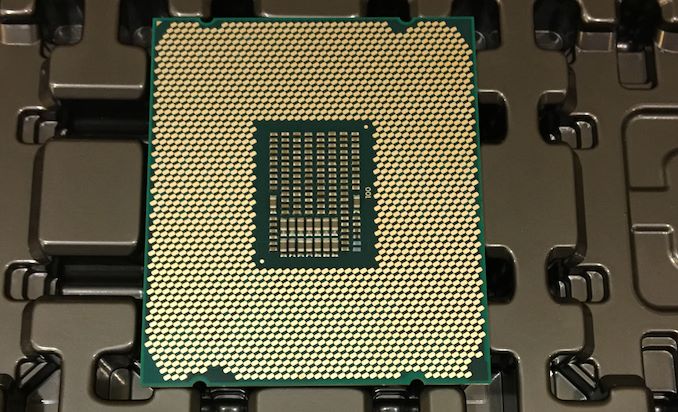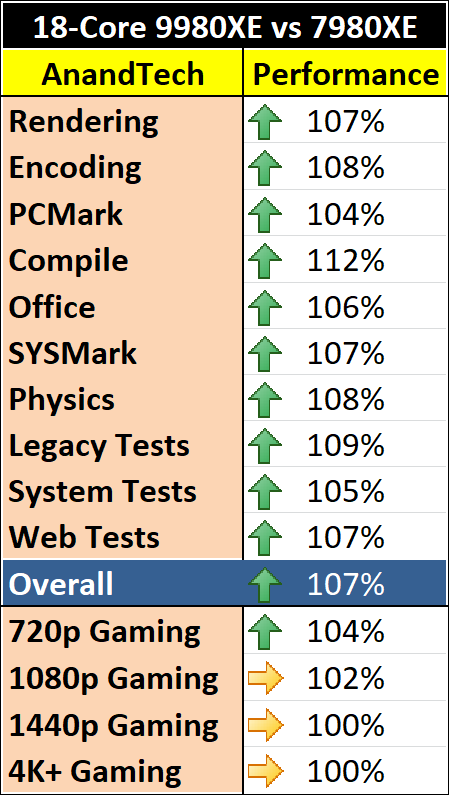The Intel Core i9-9980XE CPU Review: Refresh Until it Hertz
by Ian Cutress on November 13, 2018 9:00 AM ESTCore i9-9980XE Conclusion: A Generational Upgrade
Users (and investors) always want to see a year-on-year increase in performance in the products being offered. For those on the leading edge, where every little counts, dropping $2k on a new processor is nothing if it can be used to its fullest. For those on a longer upgrade cycle, a constant 10% annual improvement means that over 3 years they can expect a 33% increase in performance. As of late, there are several ways to increase performance: increase core count, increase frequency/power, increase efficiency, or increase IPC. That list is rated from easy to difficult: adding cores is usually trivial (until memory access becomes a bottleneck), while increasing efficiency and instructions per clock (IPC) is difficult but the best generational upgrade for everyone concerned.
For Intel’s latest Core i9-9980XE, its flagship high-end desktop processor, we have a mix of improved frequency and improved efficiency. Using an updated process has helped increase the core clocks compared to the previous generation, a 15% increase in the base clock, but we are also using around 5-6% more power at full load. In real-world terms, the Core i9-9980XE seems to give anywhere from a 0-10% performance increase in our benchmarks.
However, if we follow Intel’s previous cadence, this processor launch should have seen a substantial change in design. Normally Intel follows a new microarchitecture and socket with a process node update on the same socket with similar features but much improved efficiency. We didn’t get that. We got a refresh.
An Iteration When Intel Needs Evolution
When Intel announced that its latest set of high-end desktop processors was little more than a refresh, there was a subtle but mostly inaudible groan from the tech press at the event. We don’t particularly like generations using higher clocked refreshes with our graphics, so we certainly are not going to enjoy it with our processors. These new parts are yet another product line based on Intel’s 14nm Skylake family, and we’re wondering where Intel’s innovation has gone.
These new parts involve using larger silicon across the board, which enables more cache and PCIe lanes at the low end, and the updates to the manufacturing process afford some extra frequency. The new parts use soldered thermal interface material, which is what Intel used to use, and what enthusiasts have been continually requesting. None of this is innovation on the scale that Intel’s customer base is used to.
It all boils down to ‘more of the same, but slightly better’.
While Intel is having another crack at Skylake, its competition is trying to innovate, not only by trying new designs that may or may not work, but they are already showcasing the next generation several months in advance with both process node and microarchitectural changes. As much as Intel prides itself on its technological prowess, and has done well this decade, there’s something stuck in the pipe. At a time when Intel needs evolution, it is stuck doing refresh iterations.
Does It Matter?
The latest line out of Intel is that demand for its latest generation enterprise processors is booming. They physically cannot make enough, and other product lines (publicly, the lower power ones) are having to suffer when Intel can use those wafers to sell higher margin parts. The situation is dire enough that Intel is moving fab space to create more 14nm products in a hope to match demand should it continue. Intel has explicitly stated that while demand is high, it wants to focus on its high performance Xeon and Core product lines.
You can read our news item on Intel's investment announcement here.
While demand is high, the desire to innovate hits this odd miasma of ‘should we focus on squeezing every cent out of this high demand’ compared to ‘preparing for tomorrow’. With all the demand on the enterprise side, it means that the rapid update cycles required from the consumer side might not be to their liking – while consumers who buy one chip want 10-15% performance gains every year, the enterprise customers who need chips in high volumes are just happy to be able to purchase them. There’s no need for Intel to dip its toes into a new process node or design that offers +15% performance but reduces yield by more, and takes up the fab space.
Intel Promised Me
In one meeting with Intel’s engineers a couple of years back, just after the launch of Skylake, I was told that two years of 10% IPC growth is not an issue. These individuals know the details of Intel’s new platform designs, and I have no reason to doubt them. Back then, it was clear that Intel had the next one or two generations of Core microarchitecture updates mapped out, however the delays to 10nm seem to put a pin into those +10% IPC designs. Combine Intel’s 10nm woes with the demand on 14nm Skylake-SP parts, and it makes for one confusing mess. Intel is making plenty of money, and they seem to have designs in their back pocket ready to go, but while it is making super high margins, I worry we won’t see them. All the while, Intel’s competitors are trying to do something new to break the incumbents hold on the market.
Back to the Core i9-9980XE
Discussions on Intel’s roadmap and demand aside, our analysis of the Core i9-9980XE shows that it provides a reasonable uplift over the Core i9-7980XE for around the same price, albeit for a few more watts in power. For users looking at peak Intel multi-core performance on a consumer platform, it’s a reasonable generation-on-generation uplift, and it makes sense for those on a longer update cycle.
A side note on gaming – for users looking to push those high-frame rate monitors, the i9-9980XE gave a 2-4% uplift over our games at our 720p settings. Individual results varied from a 0-1% gain, such as in Ashes or Final Fantasy, up to a 5-7% gain in World of Tanks, Far Cry 5, and Strange Brigade. Beyond 1080p, we didn’t see much change.
When comparing against the AMD competition, it all depends on the workload. Intel has the better processor in most aspects of general workflow, such as lightly threaded workloads on the web, memory limited tests, compression, video transcoding, or AVX512 accelerated code, but AMD wins on dedicated processing, such as rendering with Blender, Corona, POV-Ray, and Cinema4D. Compiling is an interesting one, because in for both Intel and AMD, the more mid-range core count parts with higher turbo frequencies seem to do better.














143 Comments
View All Comments
nadim.kahwaji - Tuesday, November 13, 2018 - link
Niceeee , keep up the great work Ian ‘:)AshlayW - Tuesday, November 13, 2018 - link
In my opinion the entire Intel HEDT lineup is a joke. And the 9980XE: $180 more for literally just a bit over *half* the cores and threads. Sure it has better lightly threaded performance but surely that's not the intention of this processor, and surely it is not worth charging this insane 'Intel Tax' premium for it.TEAMSWITCHER - Tuesday, November 13, 2018 - link
Intel is free to charge whatever they want for a device that I have zero intention of purchasing. Most professionals I know have stopped using desktop computers for their daily drivers. The Dell XPS 15 and Apple's 15" MacBook Pro seam to be the weapons of choice these days. These products surely have their uses, but in the real world, most users are happy to sacrifice absolute performance for mobility.imaheadcase - Tuesday, November 13, 2018 - link
Most be a strange world you live on. Mobile won't ever be anything close to a desktop for daily tasks. I don't know any professional who have did that. They use mobile devices mainly to view items they did on desktop, not for working.TEAMSWITCHER - Tuesday, November 13, 2018 - link
Really? I work in software development (WEB, C++, OpenGL, and yes our own ray tracing engine) We have one guy with a desktop, the rest of the developers use either an XPS 15, a MacBook Pro, and one guy with a Surface Book. All were given a choice...this was the result.Interesting story about how we got here... Windows used to be a requirement for developing browser plugins. But with the move to Web Assembly, we can now compile and test our plugin on the Mac just as easily as we do on Windows. While many fanboys will lament this change .. I personally love it!
Endda - Tuesday, November 13, 2018 - link
Yea, for code development only. Mobility has been the choice for that for years.Not everyone is a coder though. Some need these desktops for rendering big animations, videos, etc. You're simply not going to do that in any meaningful way on a laptop
PeachNCream - Tuesday, November 13, 2018 - link
Rendering and production work can indeed happen on laptop hardware. I don't argue that desktop hardware with fewer limits on TDP and storage aren't a faster way to accomplish the same tasks, but as Team noted, given a choice, a lot of people opt for mobility over raw compute power.nerd1 - Tuesday, November 13, 2018 - link
It's a big joke to use XPS or Macbook GPU to do anything intensive. It's good for remote code editing though (except macbooks with absolute terrible keyboard)TEAMSWITCHER - Tuesday, November 13, 2018 - link
Define "intensive." Our software does real-time (WebGL) and photo-realistic (ray-tracing) rendering. I suppose that a Path Tracing engine would be MORE intensive. But the goal of our software is to be as ubiquitous as possible. We support the iPad and some Android tablets.linuxgeex - Wednesday, November 14, 2018 - link
There's your answer: anything that runs on iPad and Android Tablets is not "intensive". I'll grant you that it's "intensive" compared to what we were doing on workstations a decade ago, and mobile is closing the gap... but a workstation today has 24-56 cores (not threads) at 5Ghz and dual NVidia 2080 GPUs. You can get a 12-core CPU and dual 1080 in the pinnacle gaming laptops but they don't have ECC or the certifications of a workstation. At best they have half to 2/3 the performance. If you're paying your engineers by the hour you don't want them sitting on their hands twice as long. But I can see how they might make that choice for themselves. You make an excellent point there, lol.